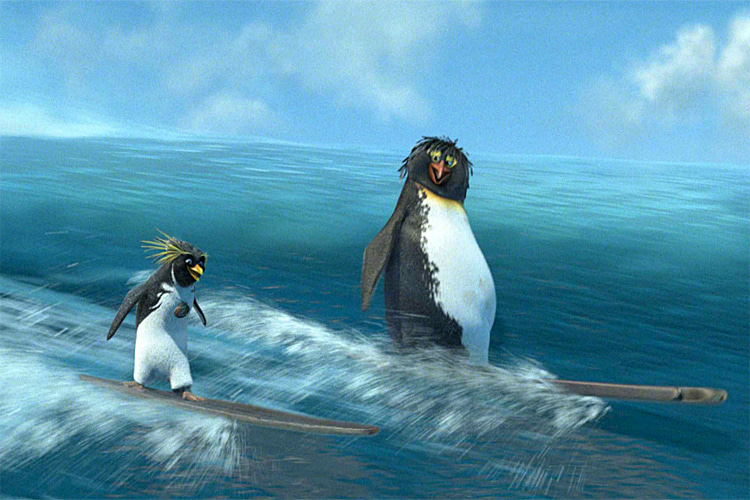"Surf's Up" is the most popular animated surf movie of all time.
The legendary high-octane penguin surfer film released in 2007 by Sony Pictures Animation took five years to see the light of day.
It required the development of new computer-generated imagery (CGI) techniques, plugins, and 3D modeling because of the difficulty of simulating ocean waves.
The movie puts the spectator inside a documentary that follows the life of Cody Maverick, a young up-and-coming rockhopper surfing star, as he prepares for his first competitive appearance.
"Surf's Up" received positive reviews from critics and has slowly become a cult classic. However, it's been considered a commercial failure.
It mimics surf and beach culture and lifestyle with its stunningly beautiful CGI rendering of perfect cartoon-like waves.
The overall authentic surf feel is also attributed to the production team involving several real-life surfers.
The world's first animated penguin surfing movie even features two very well-known professional surfers - Kelly Slater and Rob Machado - morphed into aquatic, flightless birds.
Here are some curious facts and technical secrets about "Surf's Up."
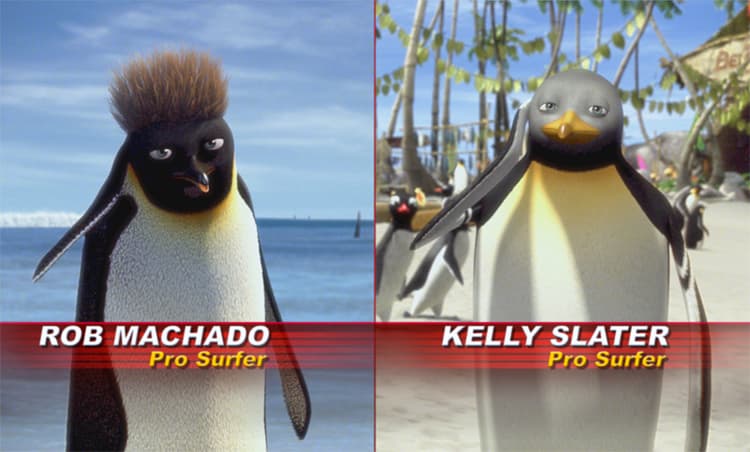
Did You Know That...
"Surf's Up" was the first-ever film by Sony Pictures Animation that didn't feature a single human and the ninth of all time.
Movie directors Ash Brannon and Chris Buck only agreed to do the movie after being assured that the waves would look realistic.
The movie's promotional poster initially included the tagline, "A True Story," but it was later replaced by "A Major Ocean Picture."
The production team made a surf-and-research trip to Malibu Surfrider Beach to study and learn more about the technicalities of surfing and surfers.
The layout team created a unique motion-capture video camera system on an old Sony video camera to give the illusion that the movie was made with a real handheld camera.
At the start of the movie, Cody is asked if he has any skills besides surfing. He replies, "Like what? Singing and dancing?" The line is a reference to "Happy Feet," another computer-animated film featuring penguins.
All the voice acting team went into the recording room together. The only exception - due to agenda conflicts - goes to Woods and Jeff Bridges, who never recorded their voices together.
Everyone was encouraged to improvise and not necessarily follow their lines at all times.
Actors and actresses used real items and objects while recording the lines for "Surf's Up." For instance, Zooey Deschanel carried a sandbag to simulate Lani's squid.
To make the voice acting more realistic, James Woods threw things at Ash Brannon when recording the scene where Reggie Belafonte throws objects at the documentary filmmaking characters.
Directors Ash Brannon and Chris Buck lent their voices to the fictional film production crew documenting the life of Cody Maverick.
The Geek character, Big Z's alter ego, is a tribute to Jeff Bridges' character, The Dude, in "The Big Lebowski" (1998).
Bridges got the voice role, even though Bill Murray, John Goodman, Kevin James, Kris Kristofferson, Mike Myers, and Ray Romano were previously considered for the job.
Drew Barrymore was considered for the role of Lani Aliikai.
Diedrich Bader is the voice of Tank Evans but also provides the voice of his mother. Both of them suffer from heterochromia, which results in different colored eyes in the same person.
Arnold, a character Lani saves from drowning, was ad-libbed by Zooey Deschanel. Directors loved him so much that he was given more screen time.
A filmmaker's daughter recorded the voices of the little girl penguin in the living room. At some point, their cat walked to the litter box, leaving a bad smell. And she says, "I think he really has to go to the bathroom right now." The directors used the remark during the penguins' interview when one of them was nervously pooping.
The panel of SPEN announcers and commentators was initially going to have Chunk, a walrus, and Rock, a seal. However, the original characters were later replaced by Kelly Slater and Rob Machado, who agreed to join the movie.
SPEN is a parody of the channel ESPN (Entertainment Sports Programming Network).
Cody's surname - Maverick - is a reference to Northern California's infamous cold water, shark-infested surf break, Mavericks.
The Big Z character was inspired by big wave surfing pioneer Greg Noll, who put an end to his career after riding a 35-foot wave at Makaha, Oahu.
The Reggie Belafonte character and hairstyle were inspired by Bill Sharp, the founder of Billabong XXL Global Big Wave Awards and project director of "Billabong Odyssey" (2003).
The name for the Big Z Memorial Surf Off was inspired by The Eddie, the surf contest formerly known as the Quiksilver in Memory of Eddie Aikau.
There are three minor characters competing in the surf contest: Tatsuhi Kobayashi (Japan), Rory Nubbins (Australia), and Renato Mendes (Brazil).
Doris and Sheila, two of Big Z's former girlfriends, appear on the beach near the end of the movie.
Cody and Lani are named after characters played by David Chokachi and Carmen Electra, respectively, in the TV series "Baywatch" (1989).
At the beginning of the movie, you hear Big Z burping. But it was John Heder who did it - not Jeff Bridges.
And yes, the famous surfing catchphrase, "You should've been here yesterday," can be heard when Cody Maverick tries to prove his skills to Abromowitz, the talent hunter who once scouted songbirds.
Cody Maverick, Edna Maverick, Glen Maverick, and Glen's friend are all southern rockhopper penguins. Zeke "Big Z" Topanga is an emperor penguin, Lani Aliikai is a gentoo penguin, Tank Evans is a king penguin, Mikey Abromowitz is a wader, Reggie Balefonte is a marine otter, Chicken Joe is a domestic chicken, and Ivan is a fire urchin.
"Surf's Up" features the song "Aloha Oe," composed by Queen Liliuokalani, the last sovereign monarch of the Hawaiian Kingdom.
Several unidentified flying objects (UFO) have been placed all around the movie.
The film's grainy look aims to be consistent and aligned with the classic documentary visual style.
"Surf's Up" features less than 900 shots, which is considered to be short for a $100 million animated movie.
The line "And now to dodgeball" featured on the Sports Penguin Entertainment Network (SPEN) broadcast is a reference to the "ESPN 8: The Ocho" joke in "Dodgeball: A True Underdog Story."
The animated mockumentary features "The Great Wave off Kanagawa," the famous picture by Japanese artist and printmaker Katsushika Hokusai, with a special twist - there's actually a penguin surfer riding it.
"Surf's Up" went from the theaters to DVD after 18 weeks.
In the Brazilian dub, Cody Maverick hails from Frio de Janeiro.
The movie lost the Oscar for Best Animated Feature to Disney and Pixar's "Ratatouille."
"Surf's Up" made $152,005,713 in the box office.
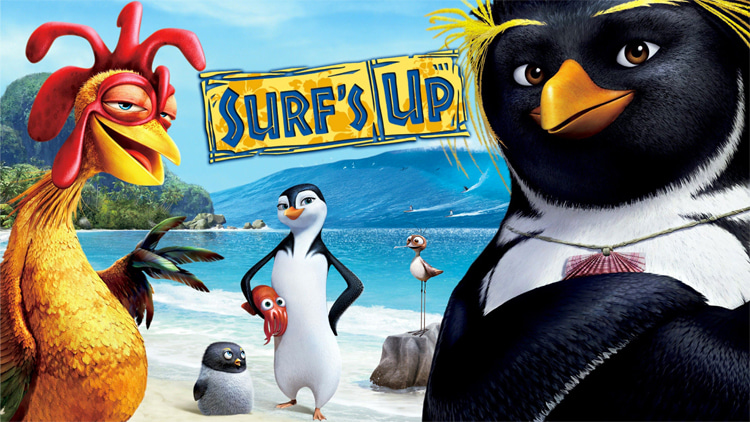
The Cast
Shia LaBeouf (Cody Maverick)
Jeff Bridges (Geek)
Zooey Deschanel (Lani Aliikai)
James Woods (Reggie Belafonte)
Diedrich Bader (Tank "The Shredder" Evans)
Jon Heder (Chicken Joe)
Mario Cantone (Mikey Abromowitz)
Kelly Slater (Himself)
Rob Machado (Himself)
Sal Masekela (SPEN Announcer)
Ash Brannon (Filmmaker #1)
Brian Posehn (Glen Maverick)
Dana L. Belben (Edna Maverick)
Reed Buck (Arnold)
Reese Elowe (Kate)
Jack P. Ranjo (Smudge)
Michael McKean (Rock)
Maddie Taylor (Ivan)
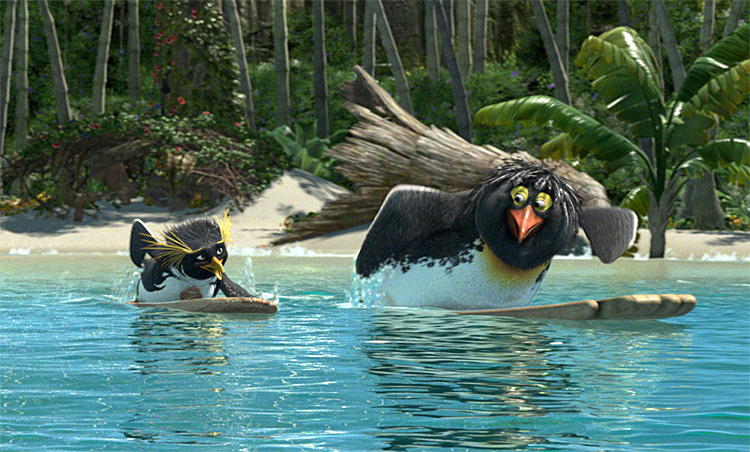
The Plot
The movie starts with a brief introduction to the history of surfing and how the early wave riders rode wood planks across the breaking waves.
Zeke "Big Z" Topanga is one of the world's first surfing legends.
The quote that can be read in a magazine is: "Surfing, for me, is something that's completely unstructured. It's the rhythm of the world. It's the physical connection to the Universe."
Zeke Topanga came to Antarctica when Cody Maverick was still a youngster. He gifted him a necklace with the Z on it.
Cody works in the fish industry and lives on an iceberg with his mother, Edna Maverick. He believes Zeke is the best wave rider on the island.
Cody's older brother Glen says Cody spends all day in the water, running away from his responsibilities.
Cody was born in Shiverpool, Antarctica, but he never met his father, Bob Maverick, who was eaten by a whale.
Cody's dream is to move away from Shiverpool. In the first minutes, Cody paddles out for a night surfing session under the full moon.
Reggie Belafonte is a local surf promoter who runs events and manages athletes.
He travels the world in search of "the next big thing." Belafonte runs the Global Recruiting Tour, a program with Mike Abromowitz as the talent scout.
The island's TV station is the Sports Penguin Entertainment Network (SPEN).
The 10th Annual Big Z Invitational Surf Off takes place at the world's surfing capital, Pen Gu Island.
Sal Masakela is the host, and Kelly Slater and Rob Machado are the commentators.
Boneyards is one the most dangerous sections of the event's wave. It had apparently claimed the life of Big Z.
The news made the headlines of "Surfer's Weekly." The legendary surfer wiped out on a massive wave while competing against up-and-coming surfer Tank "The Shredder" Evans.
Evans is a nine-time champion and loves to be the center of attention.
"Role model? No. But I do consider myself somebody that everyone should look up to," he tells the documentary filmmakers.
Tank's house has a curtain saying, "Keep out or die."
It's where he keeps his "ladies," i.e., the trophies he won in surf contests - Jill, Amy, Suzie, Briana, Shaniqua, Helga, Kitty, Jeannie, and Theresa.
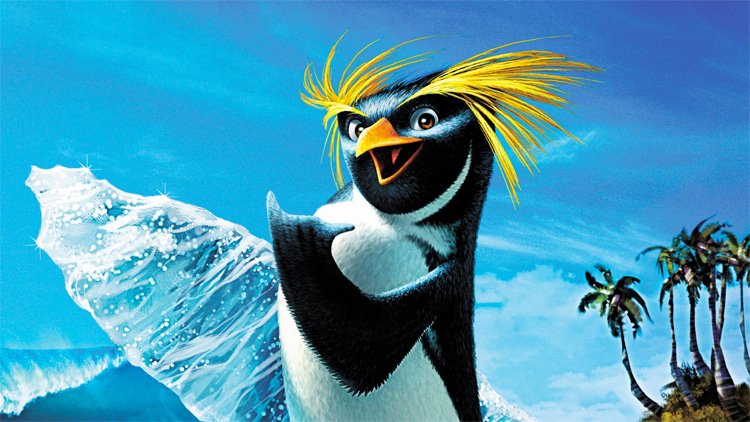
One of Cody's first opponent friends is Chicken Joe, a surfer from Sheboygan, Wisconsin.
The event's site vibe somehow mimics the Hawaiian environment, with leis, hula dance, and outdoor markets. There's even a "Z Wuz Here" memorial plaque.
Cody falls in love with Lani, a penguin lifeguard who never lost someone to drowning. She is Big Z's niece.
Big Z's iconic surfboard was broken into pieces after the deadly wipeout, but they were recovered and reassembled for a memorial statue on top of a rocky section at Boneyards.
Cody and Tank do a warm-up surf-off before the main event. The goal is to ride the biggest wave.
Evans gets barreled on a massive wave while Maverick goes over the falls, suffers a two-wave hold-down, and hits the reef.
Lani rescues Cody and brings him back to life.
One of the movie's most surreal moments is hearing Ivan, the fire urchin, complaining about being stepped on.
When Cody gets to a perfect secluded beach, he finds Big Z's surf shack, full of his iconic surfboards stacked under the old structure.
Big Z, hiding from everyone under the name Geek after the wipeout, tries to help Cody shape a surfboard made of Koa wood - "with finesse, long strokes, with the grain."
But the first model comes out as a disaster.
With the second custom-made surfboard, Cody joins Big Z and Lani for a stunning session at the local left-hand point break.
The 10th Annual Big Z Invitational Surf Off starts with 24 surfers. However, in the final, there are only three riders left: Tank Evans, Chicken Joe, and Cody Maverick.
On the last wave, Cody and Evans get caught inside at Boneyards.
Lani rescues Tank, and Big Z does the same for his pupil Cody.
In the end, Chicken Joe wins the contest, Cody finishes second, and the whole surfing community heads to the North Shore to have fun.
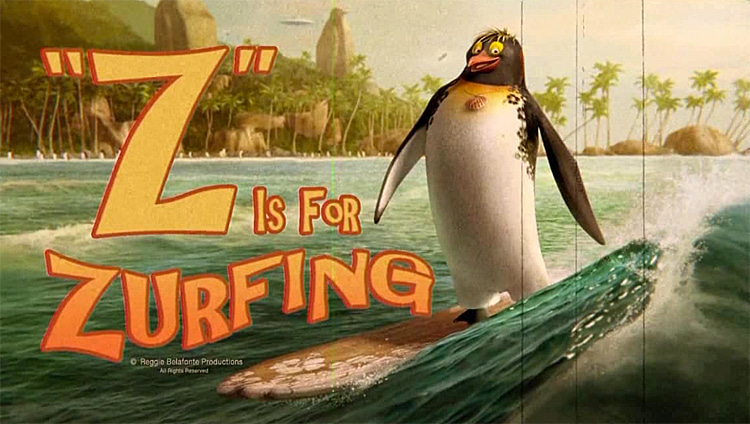
The Official Soundtrack
1. "Reggae Got Soul" - 311
2. "Drive" - Incubus
3. "Stand Tall" - Dirty Heads
4. "Lose Myself" - Lauryn Hill
5. "Just Say Yes" - Ken Andrews
6. "Forrowest" - Forro in the Dark
7. "Pocket Full of Stars" - Nine Black Alps
8. "Into Yesterday" - Sugar Ray
9. "Big Wave" - Pearl Jam
10. "Wipe Out" - The Queers
11. "Run Home (Instrumental)" - Priestess
12. "What I Like About You" - The Romantics
13. "You Get What You Give" - New Radicals
14. "Hawaiian War Chant (Ta-Hu-Wa-Hu-Wai)" - Bob Wills & His Texas Playboys
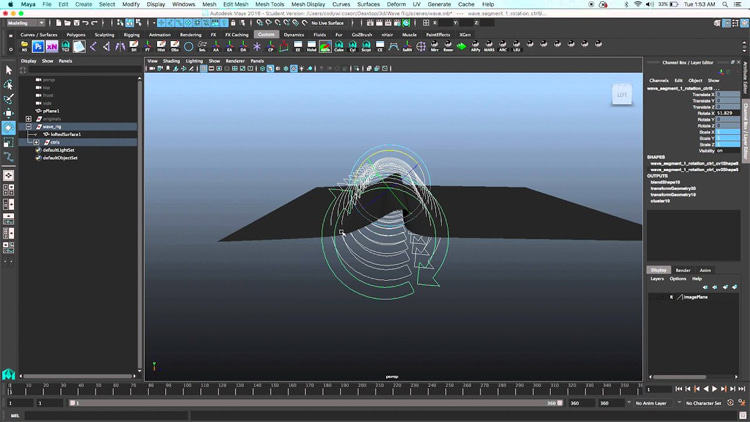
Creating Characters and Making Waves for an Animated Surf Movie
The fact that "Surf's Up" is a medium-budget documentary about surfing penguins made developers study manipulation techniques used in similar surf flicks like "Step Into Liquid" (2003) and "Second Thoughts" (2004).
But the surfing penguin movie also parodies the narratives in "North Shore" (1987) and "Riding Giants" (2004).
The documentary feel can be observed in the choices made with the camera moves, the lighting setups used throughout the movie, and the "found footage" or archive footage normally added to these types of films.
Like any good documentary, "Surf's Up" contains footage from various sources that are being used throughout the film.
This footage required an authentic "archive" feel to help inform the audience that the film has a real history (albeit fabricated).
The primary types of footage that Sony Pictures Imageworks conveyed during the film included:
- 1920s film;
- 1950s film;
- 1970s film;
- 1970s still photographs (Polaroid, Instamatic);
- Circa 2000 1st unit photography;
- Circa 2000 Video;
A large assortment of elements went into creating the various looks, including grain, film discoloration, scratches, negative and print dirt, small hairs, fuzzy projection mask, light leaks, rollouts, tape splices, lens vignetting, projection vignetting and strobing, lens color aberrations, negative/clear leader marker lines, china marker lines, video scanlines/interlace/de-interlaced method, and motion graphics.
Filmmakers and the visual effects supervisor took advantage of the speed and convenience of a handheld camera throughout production to add that special live-action feeling to the shots.
The "Surf's Up" animation crew consisted of the Animation Director, four Lead Animators, and approximately 60 Animators at full capacity.
The Lead Animators were sequence-based and would cast sequences based on their strengths and specialties.
For example, the surfing sequences were managed almost exclusively by the surfing team because of the level of specialty that surfing required.
The same applied to sequences that predominantly featured a certain character that a given crew may have shown a knack for.
It was the goal of the Directors to create a film (and environment) where the animators could truly have fun with the animation.
It was extremely important to maintain close communication between the Layout, Animation, and Effects crews for every shot that traveled through the pipe.
At no time did one department "throw-it-over-the-fence" to the next department and move on.
The smallest change (or detail overlooked) would always have a way of affecting other departments downstream.
"Surf's Up" was structured like "Survivor-style" reality TV with lots of "unrehearsed" interviews and impromptu performances along the way.
The camera was often "handheld" to produce very organic moves with the natural bumps and bobbles of a live camera operator.
There was magic in this imperfection, and that was what the "Surf's Up" team tried to capitalize on in the animation as well.
The performances needed to be portrayed as off-the-cuff, spontaneous, and real.
The result was an honest, voyeuristic glimpse into the true nature of these characters as they played out their lives before (and off) the camera.
The dialog was recorded with multiple actors improvising and playing off of each other (and talking over the top of each other as well).
This is very unusual for an animated film, where the recordings are generally more pristine and directed.
The voice tracks in this film included microphone bumps, feedback, verbal fumbling, and dialog quirks that made the voice performances feel raw and spontaneous.
The documentary format allows the characters to drive the scene.
The illusion is that the camera just "happens" to be there to capture the moment.
One of the most important elements in "Surf's Up" is the waves that are seen throughout the film - without the waves, there wasn't a story to tell.
In the early stages of production, the team was confronted with the fact that the waves defined the sequences they were in.
The waves were a moving environment created and animated in layout, similar to a standard set that would be built and dressed.
The waves included hollow tubes for a sequence in which the main characters enjoy a perfect day in the surf, as well as powerful, monstrous 60-foot waves that are showcased in the finale.
With that amount of diversity in mind, it was important to be able to define every feature of the wave and create several different types and styles of waves.
When coupled with the challenging process of animating a wave with the specific interaction of a surfer, it was ultimately decided that it was best to treat the wave as a character instead of a procedural effect.
Knowing that an entire ocean surface with an arbitrary number of waves was an impossible workflow to manage, a wave surface created in the rig was built that would eventually be connected to the ocean through a surfacing operation in Houdini.
In an effort to simplify the process even further, a decision was made to build only two rigs, each very similar but offering different levels of control that would allow the animators to create multiple wave types.
These two rigs served as the base that defined a set of three distinct wave types that would populate the film.
The "pipeline" wave was modeled after the Banzai Pipeline in Hawaii, a fast, hollow wave that breaks over a shallow reef.
The massive waves seen in Big Z's archival footage and the movie's final contest were based on the infamous Mavericks in Half Moon Bay, California - a giant, deep water wave that breaks over a rocky point.
The "spilling breaker" was a beach break wave that did not tube.
The waves' breaking/cresting motion was animated using control rings whose rotational data drove a series of predefined target curves, which were blend shaped (morphed) together to "evolve" the breaking wave.
Each blend shape target represented a period of time in the breaking motion of the wave.
The blends-shaped curves were lofted together to form the surface of the wave.
Major control rings moved multiple curves or sections of the wave, and minor control rings could control a single curve.
This level of flexibility allowed animators to have very fine control of the wave's contours.
Other controls allowed for the wave's profiles to be manipulated into the desired type.
By changing the size, shape, and timing of the wave, the rig was flexible enough to evolve a wave from a three-foot spilling breaker into a 60-foot behemoth.
One of the most informative visualization tools created for the wave rig was the whitewater plugin node.
Running in real-time, animators could see the amount of whitewater that the wave was generating as it was breaking.
The whitewater node was especially helpful in determining when and how fast the wave was breaking and also aided the animators in knowing whether the character was interacting with the whitewater properly or whether it was completely obscuring the character.
When a surfer is riding the face of the wave, the surfboard displaces a volume of water as it glides along the surface.
To aid the animators and layout artists in determining the surfer's connection to the wave, a wake trail node was created.
This node created a lofted plane that was attached to the surface of the wave, allowing the artist to visualize whether they were penetrating the surface of the water.
The lofted plane looked like a ribbon on the surface of the water, allowing animators to clearly see the path of travel over the surface of the wave and orient the board correctly along the path defined by the wake trail.
Before having the ability to visualize this path in animation, effects renders would often reveal that the board was sliding sideways along the surface of the wave (not tracking properly) and would be kicked back to animation to make the fix (a time-consuming and costly step backward).
An interesting side effect of the wake trail was that it also allowed the animators to see the speed at which the wave was traveling.
If the wake trail moved too quickly up the face of the wave, the speed of the wave would need to be adjusted.
The physical dynamics involved in surfing can be very extreme and acrobatic.
When surfers move, they engage their entire bodies from the tip of their fingers to the tip of their toes in order to throw the board around with great finesse.
An archive of surfing references was compiled and studied to get a feel for how a surfer manipulates the surfboard and how the board responds to both the surfer and the water.
The live-action reference became the pre-visualization tool.
After receiving turnover notes on a surfing shot from the Directors, a collection of surfing clips was assembled that met their criteria.
These options were pitched back to the Directors, and a clip would be chosen.
Once the surf move was approved on video, the animator could proceed with a layered approach in animation (which seemed to work best for surfing), and the reference was the basis from which the animation was built and then caricatured.
Surf footage shows that wherever a surfer puts his foot (whether it is front or back), the board will pivot around that point.
As a result, the animator needs many different pivot points on the surfboard to work with.
With this in mind, the surfboard rig was built with four major pivot points.
From the back to the front, they are "master, body, cog" and "tip."
Each of the four nodes has its own offset nodes (clean channels) with movable pivots on each so that the animator could rotate the board precisely from any location.
"Surf's Up" required a reworking of the production pipeline and a new set of tools to achieve the film's most technically difficult character - the wave.
This non-standard character required close collaboration between the Animation and Effects departments and re-thinking of the pipelines' normal flow of data between all departments.
Imageworks had many challenges: create a visually realistic wave, allow for a high level of direct ability, handle the unique interdependence and overlap between Animation, Effects, and Layout, and design a production pipeline to produce the wave as efficiently as possible with the goal of delivering over twenty minutes of surfing footage.
The Directors wanted the waves to be quite realistic and set a target of 80 percent real.
Though most of the film's characters are quite stylized, the Directors felt the waves should behave accurately to give the audience the sensation of real surfing while introducing stylization in the color palette and surface patterns.
Simplifying the complex surface properties of the wave helped to seat the stylized characters and the waves into the same world visually.
In the initial research to establish the look of the waves for "Surf's Up," it was observed that real waves are quite varied in shape, color, and motion and that it would be necessary to narrow the focus to target just a handful of wave styles and features.
Based on Art department concepts and renderings, four wave styles modeled after real waves were settled upon: Pipeline, Mavericks, Spilling Breaker, and the Swell.
This gave the "Surf's Up" team a more focused set of goals to meet in order to pare down the overwhelming variety of looks and motions that exist in the real world.
Observing the nature of surfing documentaries, the "Surf's Up" team knew that slow-motion shots were going to be an important element in the film.
All wave animation systems and particle effects systems needed to behave properly at extreme slow motion.
In order to accomplish this, it was necessary to mind and track the camera speed through the entire pipeline.
The wave animation was verified using pre-visualization tools of various wave features, including the following:
- Water Texture (also referred to as Wave Trains) - to evaluate surface stretching and compression;
- Wake Trails - to further evaluate the surface motion as well as the character speed relative to the wave;
- Whitewater Simulations - to ensure the wave was crashing properly;
Because of the challenge of creating a single wave that worked well for all departments, a library of verified wave animations was set up to be used as a starting place for new shots.
A lot of time and care went into designing a proper wave animation, which included a set of technical and aesthetic challenges such as whitewater, lip spray, foam ball, surface stretching, and the distinction between the wave and the surrounding ocean.
From the start, it was important to create methods for general and specific foam placement, erasure, dissolution, and animation.
Used not only to create a more realistic look, different foam patterns, and formations were employed to distinguish wave styles and locations from each other.
A distinction was made between "standing" foam, foam that was generated with procedural noise functions in the shader, and "interactive" foam, foam that was specifically placed or the result of a specific event like a splash or wake.
The interactive foam used the same noise functions as standing foam but was placed on the water using point clouds sampled in the reference space of the water with attributes describing search radius and density.
Similar to the whitewater, the particle simulation for the foam ball was birthed from the crash curve.
However, because the foam ball swirls around the inside of the tube of the wave, a different approach was taken in its construction.
For some of the surfing and wave effects, the forward velocity of the wave made it difficult to have precise control over the particle simulations.
One solution was to halt the wave, create the particles, and then add the forward velocity of the wave back into the simulation and adjust the velocities accordingly.
Although the characters in "Surf's Up" are quite stylized, they live in a realistic and believable world.
In order to capture the excitement of surfing, it was important to achieve a fairly high level of realism.
The viewer is in the action, surfing with our characters and experiencing the beauty of being in the perfect tube, as well as the horror of wiping out on a monster wave.
In addition to this realism, the movie contained a wide variety of waves, water, and locations.
The wave styles ranged from the cold dark waters of Antarctica to the tropical waters of Pen Gu Island and finally to the stormy and ominous waves of the competition day.
These waves were also filmed in many different lighting situations.
The style of the waves was inspired by surfing and outdoor photography and the conceptual art created by the Visual Development team.
The concept of an underwater camera housing was extended to create the look of a surfboard camera, similar to that used in sports footage.
In this case, the idea was to visually simulate the immediacy and excitement that is characteristic of filming with a small camera mounted to the surfboard.
The elements in the images on this page were composited to create the look and feel of a cheap servo-operated video camera. As Dolly Parton once said: "It takes a lot of money to look this cheap."
Some of the individual elements that were characteristic of this look are listed below:
- Little motion blur (step printing for slow motion and skip printing to speed up action);
- Larger depth-of-field to simulate small, cheap lens;
- Video lines;
- Video dropouts;
- Simulated servo-controlled movement;
- Video color;
- Vignette from cheap camera housing with an imperfect fit;
- Splashes and water drops on the lens;
Bibliography and References:
Rob Bredow, David Schaub, Daniel Kramer, Matthew Hausman, Danny Dimian, R. Stirling Duguid. "Surf's Up: The Making of an Animated Documentary." Sony Pictures Imageworks, 2007
